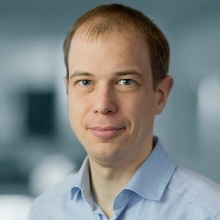Contact
+49 711 685 64473
+49 711 685 64442
Email
Pfaffenwaldring 55
70569 Stuttgart
Deutschland
Room: 1.837
Scientific Career
| since 2014 | Professor for Computational Chemistry (W3), Universität Stuttgart, Institute for Theoretical Chemistry and Stuttgart Research Centre for Simulation Technology and Cluster of Excellence "Simulation Technology" (SimTech) |
| 2008–2014 | Juniorprofessor, Applied Quantum Mechanics, Universität Stuttgart, Institute of Theoretical Chemistry and Stuttgart Research Centre for Simulation Technology and Cluster of Excellence "Simulation Technology" (SimTech), Tenure-track |
| 2006–2008 | Research staff in the Scientific Computing Department of the STFC (previously: CCLRC) at Daresbury Laboratory, UK |
| 2004–2006 | Postdoctoral researcher with Walter Thiel, Max-Planck-Institut für Kohlenforschung, Mülheim an der Ruhr, Germany |
| 2001–2004 | Scientific coworker (doctoral student) with Peter E. Blöchl, Clausthal University of Technology, Germany |
Education
| 2014 | Habilitation in Theoretical Chemistry |
| 2004 | Dr. rer. nat. (summa cum laude) in theoretical physics with Peter E. Blöchl, Clausthal University of Technology, Institute of Theoretical Physics |
| 2001 | Master's degree in chemistry with K.-H. Schwarz, Vienna University of Technology, Institute of Physical and Theoretical Chemistry (now Institute of Materials Chemistry) |
| 1996–2001 | Studies of Chemistry ("technische Chemie"), Vienna University of Technology. 1997–2001 additionally studies of physics |
Prizes and Awards
| 2015 | OYGA Award of the The Lise Meitner-Minerva Center for Computational Quantum Chemistry, Israel |
| 2012 | Hans G.A. Hellmann prize of the German Arbeitsgemeinschaft für Theoretische Chemie |
[19] “Quantum Chemical Simulations for Astrochemistry” Jan Meisner in “Proceedings of the 3rd bwHPC-Symposium” Sabine Richling, Martin Baumann, Vincent Heuveline (Eds.) (2017)
[18] “Free Energy Calculation Methods and Rare Event Sampling Techniques for Biomolecular Simulations” Jens Smiatek, Niels Hansen and Johannes Kästner in “Simulating Enzyme Reactivity: Computational Methods in Enzyme Catalysis” Inaki Tunon, Vicent Moliner (Eds.) (2016)
[17] “Preisgekrönt: Forscher mit Tunnelblick” Stuttgarter Zeitung (2015)
[16] Press release “Prof. Johannes Kästner erhält ERC Consolidator Grant des Europäischen Forschungsrats - Zwei Millionen Euro für Untersuchung des quantenmechanischen Tunneleffekts” Hochschulkommunikation, University of Stuttgart (2015)
[15] “Der Tunneleffekt in der Chemie” Johannes Kästner, Themenheft Forschung der Universität Stuttgart, 10 (2014)
[14] “A Tale of 7 Elements” by Eric Scerri, book review by Andrea Kästner, Johannes Kästner, Angew. Chem., Int. Ed. 53, 2538 (2014); German version: Angew. Chem. 126, 2572 (2014)
[13] “Der Tunneleffekt in chemischen Reaktionen” Johannes Kästner Bunsenmagazin p. 15 1/2014.
[12] “Tunneleffekt und Katalyse” Radio interview in Deuschlandfunk of Johannes Kästner by Hellmuth Nordwig 2013.
[11] “Durch Abkürzung schneller zum Ziel: Simulation des Tunneleffekts für große Moleküle” Johannes Kästner. Mediendienst Forschung, University of Stuttgart, 2011. (pdf)
[10] “QM/MM: Die Kombination aus Quantenmechanik und empirischen Kraftfeldern” Johannes Kästner. Trendbericht in the Nachrichten aus der Chemie, 2011.
[9] “Excited State and Parallel Geometry Optimisation with DL-FIND” Thomas W. Keal, Joanne M. Carr, Adrian Wander, Paul Sherwood, Johannes Kästner. Chapter in “Frontiers 2009” – CSE Department's annual report for 2009.
[8] “Complex energy landscapes revealed: The phosphorylation reaction in protein kinase A” M. Montenegro, M. Garcia-Viloca, À. González-Lafont, J.M. Lluch, J. Kästner, J.M.H. Thomas, H.J.J. van Dam, and P. Sherwood. Chapter in “Frontiers 2008” – CSE Department's annual report for 2008.
[7] “Larger and longer: atomistic and coarse-grained simulations of the Epidermal Growth Factor Receptor” Hannes H. Loeffler, Johannes Kästner and Martyn D. Winn. Chapter in “Frontiers 2008” – CSE Department's annual report for 2008.
[6] “Finding Minima, Transition States, and Conical Intersections: the Development of a Geometry Optimiser for Atomistic Simulation Codes” Johannes Kästner and Paul Sherwood. Chapter in “Frontiers 2007” – CSE Department's annual report for 2007.
[5] “CSED Software to Leap Ahead” Adrian Wander, Paul Sherwood, William Smith, Coralia Cartis, Johannes Kästner, et al. Chapter in “Frontiers 2007” – CSE Department's annual report for 2007.
[4] “New Tools for the Accurate Study of Biomolecular Reactivity” Johannes Kästner, Paul Sherwood, Hans Martin Senn, Stephan Thiel, Nikolaj Otte, Walter Thiel. Chapter in “Frontiers 2006” – CSE Department's annual report for 2006.
[3] Book chapter “Electronic structure methods: Augmented Waves, Pseudopotentials and the Projector Augmented Wave method” Peter E. Blöchl, Johannes Kästner, Clemens J. Först, in “Handbook of Materials Modeling, Volume I (Methods and Models)” S. Yip Ed., Springer, ISBN: 1-4020-3287-0, May 2005.
[2] Ph.D. thesis “Biological Nitrogen Fixation – Simulation of the Reaction Mechanism of Nitrogenase from First Principles” Johannes Kästner, Clausthal University of Technology (2004) pdf (6.7MB).
[1] Master thesis (diploma thesis) “Linkage Isomers of Transition Metal Nitrosyl Complexes studied by ab-initio Molecular Dynamics” Johannes Schimpl, Vienna University of Technology (2001).
- Kinderuni Weil der Stadt, Germany: Wie man die Bausteine der Welt am Computer sichtbar machen kann, November 28, 2019
- Tag der Wissenschaft, Stuttgart, Germany: Computer als Mikroskop? Eine Livereportage aus dem Reagenzglas., June 20, 2015
- AK Astronomie, Stuttgart, Germany. Astrochemie – Moleküle zwischen Sternen, June 10, 2015
- “Tunneleffekt und Katalyse” Radio interview in Deuschlandfunk of Johannes Kästner by Hellmuth Nordwig 2013.


